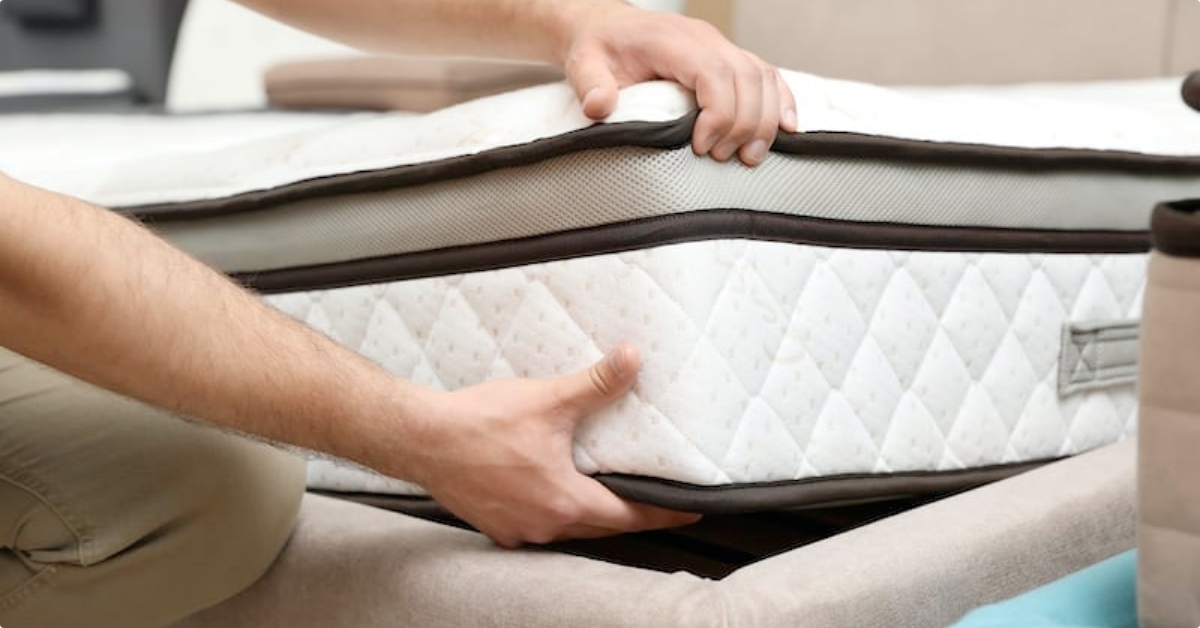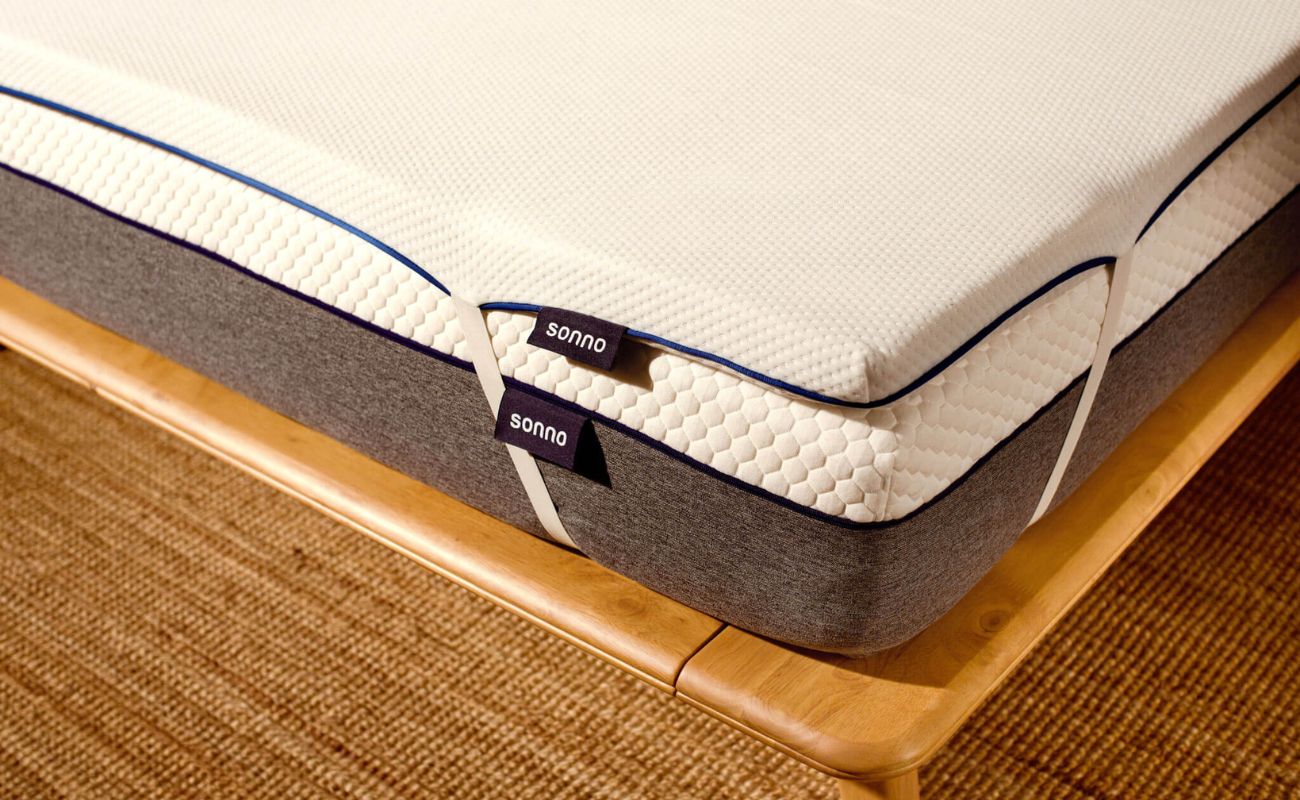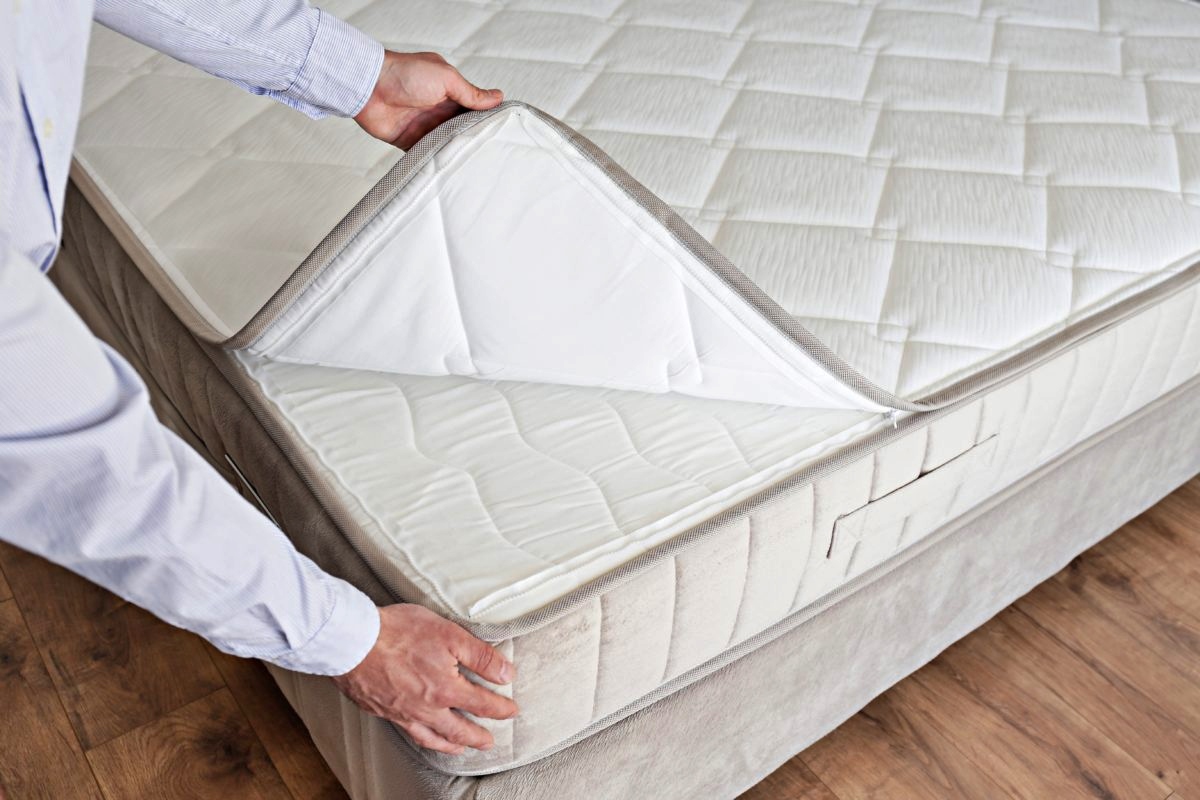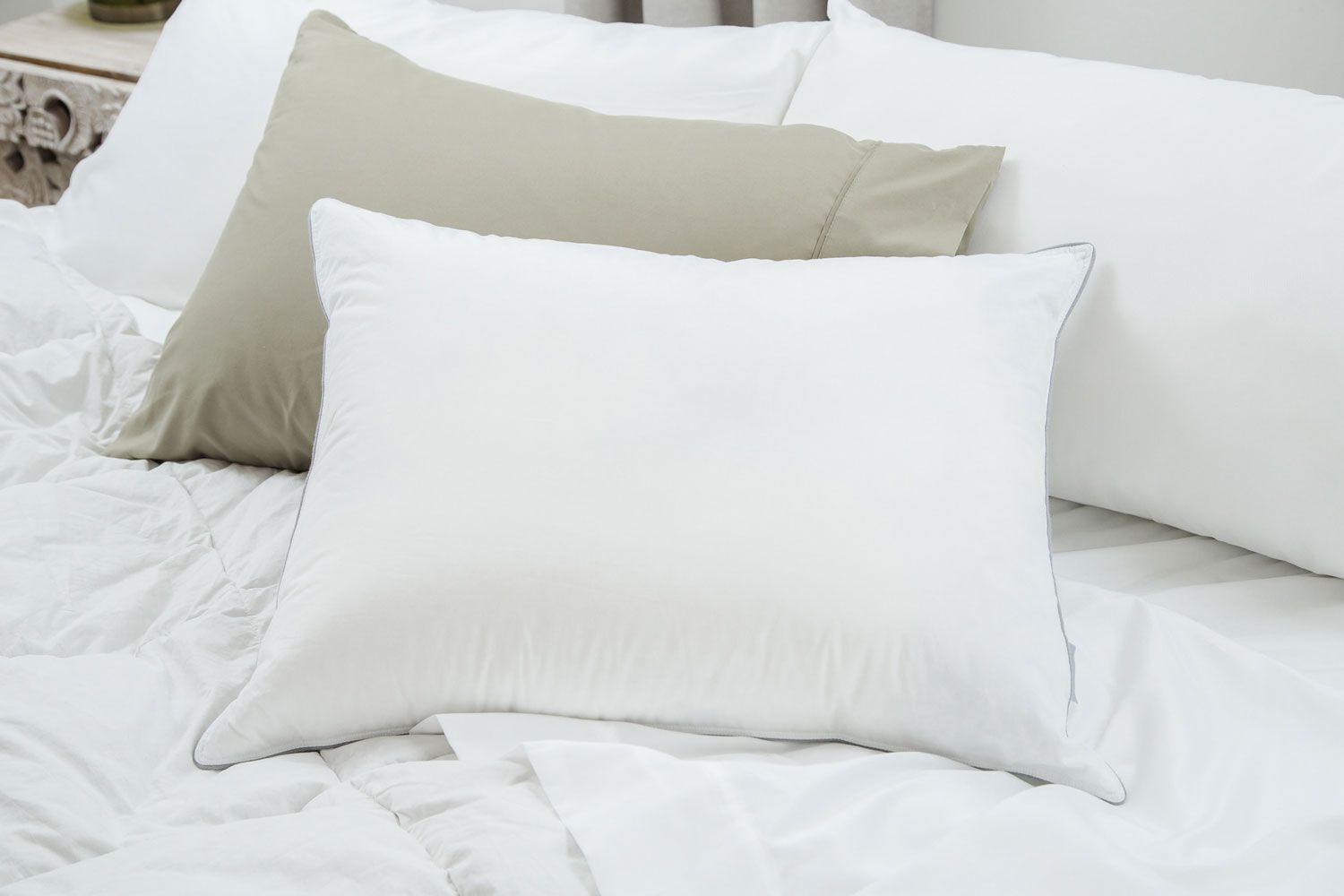Home>Interior Design>How To Choose A Pillow: For Your Sleep Position And Mattress


Interior Design
How To Choose A Pillow: For Your Sleep Position And Mattress
Modified: January 18, 2024
Discover the best pillow for your sleep position and mattress with our comprehensive guide. Get expert tips on choosing the perfect pillow for a comfortable and healthy sleep.
(Many of the links in this article redirect to a specific reviewed product. Your purchase of these products through affiliate links helps to generate commission for Storables.com, at no extra cost. Learn more)
Introduction
Choosing the right pillow is an essential aspect of creating a comfortable and supportive sleep environment. A good pillow not only enhances the quality of your sleep but also plays a crucial role in maintaining proper spinal alignment. However, with so many options available in the market, finding the perfect pillow can be a daunting task.
The importance of selecting the right pillow should not be underestimated. A pillow that is well-suited to your sleep position and mattress type can help alleviate discomfort, reduce neck and shoulder pain, and promote better sleep quality. On the other hand, using the wrong pillow can lead to sleep disturbances, restless nights, and even chronic pain.
In this article, we will explore the factors you should consider when choosing a pillow, including your sleep position, mattress type, and personal preferences. We will also discuss the different types of pillows available and provide recommendations based on various sleep positions and mattress types. By the end, you will have a better understanding of how to select the perfect pillow for your individual needs.
Remember, a good pillow is not a one-size-fits-all solution. What works for one person may not work for another, so it’s important to consider your specific circumstances when making your choice. Whether you’re a side sleeper, back sleeper, stomach sleeper, or a combination of all three, there is a pillow out there that can provide the right amount of support and comfort for you.
So, let’s dive into the world of pillow selection and discover how you can make an informed choice to revolutionize your sleeping experience.
Key Takeaways:
- The right pillow is crucial for spinal alignment, sleep quality, and pain reduction. Consider your sleep position, mattress type, and personal preferences to find the perfect pillow for a restful night’s sleep.
- Additional factors like allergies, temperature regulation, and pillow maintenance are essential for optimal sleep comfort. Investing in the right pillow is an investment in your sleep health and overall well-being.
Read more: How To Position Pillows
Importance of Choosing the Right Pillow
Selecting the right pillow is not only about comfort and support; it also plays a vital role in promoting spinal alignment and reducing the risk of pain and discomfort. Here are some reasons why choosing the right pillow is important for your overall well-being:
1. Proper spinal alignment: A well-chosen pillow helps maintain the natural alignment of your spine while you sleep. It supports the head, neck, and shoulders, keeping them in a neutral position. This alignment minimizes the risk of waking up with a stiff neck, headaches, or back pain.
2. Enhanced sleep quality: The right pillow can significantly improve the quality of your sleep. It promotes relaxation, reduces tossing and turning, and helps you maintain a comfortable sleep position throughout the night. By providing adequate support, it minimizes sleep disturbances, allowing you to wake up feeling refreshed and rejuvenated.
3. Reduced neck and shoulder pain: The wrong pillow can cause muscle strain and put unnecessary pressure on the neck and shoulders. This can lead to chronic pain and discomfort. Choosing a pillow that provides proper support for your sleeping position can alleviate these issues and prevent pain-related sleep disturbances.
4. Allergen prevention: Many pillows are hypoallergenic and designed to repel dust mites, mold, and other allergens. By choosing the right pillow, you can minimize the risk of allergic reactions, asthma flare-ups, and nighttime allergies. This is particularly important for individuals with respiratory conditions or allergies.
5. Personalized comfort: Everyone has different preferences when it comes to pillow comfort. Choosing one that suits your personal needs and preferences ensures a comfortable and restful sleep experience. Whether you prefer a soft, medium, or firm pillow, having the right level of comfort can greatly enhance your sleep quality.
6. Longevity and durability: Investing in a high-quality pillow that is suitable for your sleep position and mattress can lead to increased durability and longevity. By choosing a pillow that holds its shape and maintains its support over time, you can avoid the need for frequent replacements and save money in the long run.
Remember, the right pillow is a crucial component in achieving a good night’s sleep. It not only provides physical support but also contributes to your overall sleep hygiene. So, take the time to choose a pillow that meets your specific needs and preferences. Your body will thank you for it as you experience improved sleep quality and wake up feeling refreshed and ready to take on the day.
Factors to Consider When Choosing a Pillow
When it comes to selecting the perfect pillow, there are several important factors to consider. Taking into account your sleeping position, type of mattress, and personal preferences will help you find a pillow that provides optimal comfort and support. Here are the key factors to keep in mind:
1. Sleeping position: Your sleeping position plays a significant role in determining the type of pillow that will best suit your needs. Different sleep positions require varying levels of support to maintain proper spinal alignment. For example:
– Side sleepers: A medium-firm to firm pillow with a higher loft is ideal for side sleepers. This helps fill the gap between the head and shoulder, keeping the spine properly aligned.
– Back sleepers: Back sleepers typically require a medium-firm pillow with a medium loft. This provides adequate support to the natural curve of the neck and keeps the head aligned with the spine.
– Stomach sleepers: Stomach sleepers will benefit from a soft and low-loft pillow or even no pillow at all. This prevents excessive strain on the neck and helps maintain neutral alignment.
– Combination sleepers: If you change positions frequently throughout the night, a versatile pillow that offers medium support and adapts to different sleep positions may be the best option.
2. Type of mattress: The type of mattress you have can also influence the choice of pillow. Different mattresses provide varying levels of support and firmness, so it’s essential to consider how a pillow will interact with your mattress. For example:
– Innerspring mattress: An innerspring mattress with bouncy support may require a slightly softer pillow to provide the necessary contouring and cushioning.
– Memory foam mattress: Memory foam mattresses conform to the body’s shape, so a pillow that offers sufficient support and contouring is recommended.
– Latex mattress: Latex mattresses provide a responsive and supportive surface, making a pillow with medium firmness and loft an ideal match.
– Hybrid mattress: Hybrid mattresses combine the support of innerspring coils with the contouring properties of foam, necessitating a pillow that can accommodate both qualities.
3. Personal preferences: Your personal preferences, such as pillow filling, thickness, and firmness, should not be overlooked. Some common pillow filling options include:
– Down pillows: Luxuriously soft and lightweight, down pillows are filled with the fluffy undercoating of geese or ducks. They offer plush comfort and excellent contouring.
– Feather pillows: Feather pillows have a firmer feel than down pillows, providing good support and breathability.
– Synthetic fill pillows: Made from hypoallergenic materials like polyester, synthetic fill pillows offer affordability and a wide range of firmness options.
– Memory foam pillows: Memory foam pillows conform to your shape, reducing pressure points and providing personalized support.
– Latex pillows: Latex pillows are highly durable, hypoallergenic, and offer a supportive yet buoyant feel.
Consider your preferences regarding pillow thickness and firmness as well. Thickness, also known as loft, refers to the height of the pillow and can vary from low to medium to high based on your needs. Firmness ranges from soft to medium firm to firm, with the right choice depending on your desired level of support and comfort.
Ultimately, finding the perfect pillow involves a combination of these factors. Evaluate your sleeping position, mattress type, and personal preferences to narrow down the options and select a pillow that provides the ideal balance of comfort and support. Remember, investing in the right pillow is an investment in your quality of sleep and overall well-being.
Pillows for Different Sleep Positions
Choosing the right pillow for your sleep position is crucial for maintaining proper spinal alignment and ensuring a restful night’s sleep. Here are some recommendations for pillows based on different sleep positions:
1. Side sleepers: Side sleepers tend to put more pressure on their shoulders and hips. To keep the spine aligned, it is crucial to choose a pillow that fills the gap between the head and shoulder. A medium-firm to firm pillow with a higher loft (thickness) is recommended to provide adequate support. Look for pillows specifically designed for side sleepers, as they often have a contoured shape or a gusseted design to provide better support for the neck and head.
2. Back sleepers: Back sleepers benefit from a pillow that supports the natural curve of the neck and allows the head to rest in a neutral position. A medium-firm pillow with a medium loft is ideal for back sleepers. Look for pillows with a slightly rounded bottom or a scalloped edge to cradle the neck while keeping the head aligned with the spine. Memory foam or latex pillows can provide the necessary support and contouring for back sleepers.
3. Stomach sleepers: Stomach sleeping puts strain on the neck and can lead to discomfort and misalignment. It is generally recommended to avoid using a pillow or opt for an ultra-thin, soft pillow if needed. This helps minimize strain on the neck and keeps the spine in a more neutral position. Look for stomach sleeper pillows that are specifically designed to be thin and soft, allowing for optimal comfort without compromising the alignment of the spine.
4. Combination sleepers: Combination sleepers switch between various sleep positions throughout the night. For these sleepers, versatility and adaptability are key. A pillow that offers medium support and can adjust to different sleeping positions is recommended. Memory foam pillows or shredded memory foam pillows that can be molded to fit your desired shape are great options for combination sleepers. Look for pillows with adjustable loft or pliability to accommodate your changing sleep positions.
When selecting a pillow for your sleep position, be mindful of the material and filling. Down, feather, memory foam, and latex pillows are common choices, each offering different levels of support and comfort. Additionally, consider pillows with cooling properties or moisture-wicking covers if you tend to sleep hot.
Remember, the goal is to find a pillow that properly aligns your spine, provides support, and promotes comfortable sleep. Understanding your sleep position and finding the right pillow for it will contribute significantly to your overall sleep quality and well-being.
Choosing the Right Pillow for Your Mattress Type
When selecting a pillow, it’s important to consider the type of mattress you have. Different mattresses provide varying levels of support, firmness, and contouring. Here are some recommendations on choosing the right pillow for different mattress types:
1. Innerspring mattress: Innerspring mattresses are known for their bouncy support and responsiveness. If you have an innerspring mattress, a pillow that offers a slightly softer feel can be a good choice. A pillow with medium firmness, capable of contouring to your head and neck while providing adequate support, is recommended. Look for pillows with down or down alternative fillings, memory foam, or hybrid pillows that combine the benefits of various materials for optimal comfort and support.
2. Memory foam mattress: Memory foam mattresses are known for their contouring properties, providing pressure relief and support to the body. A pillow that complements the properties of the memory foam mattress is essential. Memory foam pillows are an excellent option for these mattresses as they offer consistent support and conform to the shape of your head and neck. Look for pillows with ergonomic designs that promote proper spinal alignment and minimize pressure points.
3. Latex mattress: Latex mattresses are known for their durability, resilience, and natural responsiveness. They provide a supportive and buoyant surface for sleep. For a latex mattress, a pillow that offers both support and breathability is recommended. Latex pillows, made from the same material as the mattress, are a popular choice as they provide consistent support and excellent airflow. Look for pillows that are made with natural latex for added environmental benefits.
4. Hybrid mattress: Hybrid mattresses combine the support of innerspring coils with the contouring properties of foam or latex layers. With the combination of these materials, it’s important to choose a pillow that can accommodate both qualities. A versatile pillow that provides medium firmness and has good contouring abilities is recommended for a hybrid mattress. Pillows with adjustable loft, shredded memory foam, or combination fillings can offer the flexibility and support needed for this type of mattress.
When choosing a pillow for your mattress type, it’s also essential to consider your sleep position and personal preferences, as they play a significant role in finding the right level of support and comfort. Additionally, keep in mind factors such as allergies, breathability, and pillow maintenance when making your selection.
Remember, the goal is to find a pillow that complements the qualities of your mattress, provides proper support, and enhances your overall sleep experience. By considering the unique features of your mattress, you can find a pillow that creates the perfect combination for a restful and comfortable night’s sleep.
When choosing a pillow, consider your sleep position and mattress firmness. Side sleepers may need a firmer pillow, while back and stomach sleepers may prefer a softer one. Match the pillow to your mattress firmness for optimal support.
Pillow Filling Options
Choosing the right pillow filling is essential for finding the perfect balance of comfort, support, and breathability. Different pillow fillings offer unique qualities and benefits. Here are some popular pillow filling options to consider:
1. Down pillows: Down pillows are filled with the soft, fluffy undercoating found beneath the feathers of geese or ducks. They are known for their luxurious feel and exceptional comfort. Down pillows offer excellent cushioning and contouring abilities, allowing them to mold to the shape of your head and neck. They provide a light and airy feel, making them ideal for those who prefer a softer pillow. It’s important to note that some individuals may have allergies or sensitivities to down, so it’s essential to check for hypoallergenic options.
2. Feather pillows: Feather pillows, like down pillows, use feathers from geese or ducks to provide cushioning and support. Feather pillows tend to be firmer than down pillows and can retain their shape well. They offer a balance between softness and support and are suitable for individuals who prefer a slightly firmer pillow. However, they may not contour as well as down pillows.
3. Synthetic fill pillows: Synthetic fill pillows are made from man-made materials such as polyester fibers. They come in a variety of firmness levels and offer hypoallergenic options. Synthetic fill pillows are generally more affordable than natural fill pillows and provide good support and durability. They are a great option for those with allergies or individuals seeking an alternative to natural fillings.
4. Memory foam pillows: Memory foam pillows are made from a viscoelastic material that responds to heat and pressure, conforming to the shape of your head and neck. They provide excellent support and can help alleviate pressure points. Memory foam pillows distribute weight evenly and help maintain proper spinal alignment. They are ideal for individuals who prefer firmer support and are looking for relief from neck or shoulder pain.
5. Latex pillows: Latex pillows are made from natural or synthetic latex foam. Natural latex is derived from the sap of rubber trees and is known for its durability, resilience, and natural cooling properties. Latex pillows provide consistent support, contouring to the shape of your head without sinking too much. They are hypoallergenic, resistant to dust mites and mold, and offer good breathability.
When choosing a pillow filling, it’s important to consider your sleep position, personal preferences, and any allergies or sensitivities you may have. Additionally, consider factors such as breathability, temperature regulation, and ease of maintenance when making your selection.
It’s worth noting that some pillows may combine different fillings or have a combination of materials, offering a unique blend of comfort and support. Exploring different filling options and trying them out can help you determine which one best meets your specific needs and preferences.
Remember, selecting the right pillow filling is essential for creating a comfortable and supportive sleep environment that promotes restful and rejuvenating sleep.
Pillow Thickness and Loft
The thickness or loft of a pillow refers to its height or how thick it appears when placed on a surface. Choosing the appropriate pillow thickness is essential for maintaining proper spinal alignment and ensuring a comfortable sleep experience. Here are the different levels of pillow thickness and loft to consider:
1. Low loft pillows: Low loft pillows, also known as slim or thin pillows, have a lower height and offer minimal elevation. These pillows are ideal for individuals who prefer a flatter surface and sleep on their stomachs or have smaller frames. Low loft pillows provide gentle support and help maintain a more neutral alignment of the head and neck.
2. Medium loft pillows: Medium loft pillows have a moderate height and are the most commonly used type of pillow. They offer a balance of support and comfort for different sleep positions. Medium loft pillows work well for back sleepers and provide adequate support to keep the head, neck, and spine aligned while still offering a level of cushioning.
3. High loft pillows: High loft pillows, also known as thick or extra-fill pillows, have a greater height and offer increased elevation. These pillows are suitable for side sleepers or individuals who prefer a more elevated sleep surface. High loft pillows help fill the gap between the head and the mattress, providing optimal support and aligning the spine for side sleepers.
When choosing the right pillow thickness and loft, consider your sleep position and personal preferences. Here are some factors to keep in mind:
– Sleep position: Side sleepers generally benefit from higher loft pillows to maintain proper spinal alignment, while back sleepers may prefer medium loft pillows. Stomach sleepers often find low loft pillows more comfortable to avoid excessive strain on the neck.
– Shoulder width: Individuals with broader shoulders may prefer higher loft pillows to ensure adequate support and fill the space between the head and shoulders.
– Mattress firmness: The firmness of your mattress also plays a role in selecting the right pillow loft. Softer mattresses may require higher loft pillows to provide additional support, while firmer mattresses may work well with medium loft pillows.
– Personal preference: Ultimately, your personal preference and comfort should guide your choice. Experiment with different pillow thicknesses and lofts to find the one that suits your individual needs, provides proper support, and enhances your sleep experience.
Remember, the goal is to find a pillow that maintains a neutral alignment of the head, neck, and spine while providing optimal comfort. Choosing the right pillow thickness and loft can greatly contribute to achieving this balance and ensuring a restful night’s sleep.
Pillow Firmness
Choosing the right pillow firmness is crucial for finding optimal support and comfort while you sleep. The firmness level of a pillow determines its feel when pressure is applied. Each firmness level offers different benefits and suits various sleep preferences. Here are the different levels of pillow firmness to consider:
1. Soft pillows: Soft pillows provide a plush and cozy feel. They offer a sinking sensation and conform closely to the contours of your head and neck. Soft pillows are ideal for individuals who prefer a cushiony, cloud-like sleep surface. They provide gentle support and are often recommended for stomach sleepers to maintain a neutral alignment and reduce pressure on the neck.
2. Medium firm pillows: Medium firm pillows strike a balance between softness and support. They provide a moderate amount of sinkage and contouring without sacrificing adequate support. Medium firm pillows are suitable for many sleepers, including back sleepers and some side sleepers. They offer a comfortable blend of cushioning and spinal alignment.
3. Firm pillows: Firm pillows offer significant support and minimal sinkage. They provide a stable and supportive sleep surface that keeps the head and neck aligned with the spine. Firm pillows are recommended for individuals who prefer a more elevated sleep position, particularly side sleepers who need extra support to align the spine properly.
When selecting the right pillow firmness, consider the following factors:
– Sleep position: Your sleep position plays a significant role in determining the ideal pillow firmness. Side sleepers typically benefit from firmer pillows, as they provide the necessary support to maintain spinal alignment. Back sleepers may find medium firmness pillows comfortable, while stomach sleepers generally prefer softer pillows to prevent strain on the neck.
– Body type and weight: Your body type can influence your pillow firmness preference. Individuals with larger frames or broader shoulders may find firmer pillows more supportive, while those with smaller frames may prefer softer pillows.
– Personal comfort preference: Ultimately, your personal preference should guide your choice. Experiment with different levels of firmness to find the one that provides the right combination of support and comfort for you.
Keep in mind that pillow firmness can also interact with the firmness of your mattress. Softer mattresses may require firmer pillows for additional support, while firmer mattresses may work well with medium to soft pillows for added comfort.
It’s important to note that the firmness of a pillow can vary among different brands and materials. If possible, try out different options to determine which firmness level suits you best.
Remember, finding the right pillow firmness is essential for maintaining proper spinal alignment and ensuring a restful sleep experience. Consider your sleep position, body type, and personal comfort preferences to select a pillow that provides the perfect level of support and comfort for you.
Additional Considerations When Selecting a Pillow
Choosing the right pillow involves more than just considering sleep position, mattress type, pillow filling, and firmness. Additional factors such as allergies and sensitivities, temperature regulation, and pillow covers and maintenance should also be taken into account. Here are some important considerations to keep in mind:
1. Allergies and sensitivities: If you have allergies or sensitivities, it’s crucial to choose a pillow that is hypoallergenic and resistant to common allergens like dust mites, mold, and mildew. Materials such as memory foam, latex, or synthetic fibers are naturally hypoallergenic and can be a suitable choice. Look for pillows with certifications like Oeko-Tex Standard 100 or CertiPUR-US, which ensure that the pillow is free from harmful chemicals and allergens.
2. Temperature regulation: Some people naturally sleep hot, while others tend to feel cold during the night. If you’re prone to overheating, look for pillows with cooling properties. These may include incorporating breathable materials like bamboo or mesh covers, or using cooling gel-infused memory foam. On the other hand, if you tend to feel cold, seek out pillows with insulating properties such as down or feather fillings. These materials can help retain body heat and provide warmth.
3. Pillow covers and maintenance: The pillow cover is an essential component that can affect comfort, durability, and hygiene. Look for pillow covers made from breathable and moisture-wicking fabrics, such as cotton or bamboo, to help regulate temperature and keep you comfortable. Additionally, choose pillow covers that are removable and machine washable for easy maintenance and cleaning.
Regular maintenance is crucial for keeping your pillow clean and in good condition. Follow the manufacturer’s care instructions, which may include fluffing, spot cleaning, or washing the pillow cover. Many pillows can be refreshed by placing them in the dryer on a low-heat setting with dryer balls or tennis balls to help restore their loft and shape.
It’s also important to note that pillows have a lifespan, and they should be replaced periodically. On average, pillows should be replaced every 1 to 2 years, depending on their quality and usage. Over time, pillows can lose their support, accumulate allergens, and become less comfortable. As a general rule, if your pillow is no longer providing adequate support or is visibly worn out, it’s time for a replacement.
By considering these additional factors, you can ensure that your pillow choice aligns with your specific needs and preferences. Whether it’s catering to allergies and sensitivities, maintaining a comfortable temperature, or ensuring easy maintenance, paying attention to these details will contribute to an optimal sleep environment.
Remember, investing in the right pillow and practicing good pillow hygiene can significantly enhance your sleep quality, comfort, and overall well-being.
Read more: How To Position Pillows For Pregnancy
Conclusion
Choosing the right pillow is a crucial step in creating a comfortable and supportive sleep environment. By considering factors such as sleep position, mattress type, pillow filling, firmness, and additional considerations, you can find the perfect pillow to enhance your sleep quality and overall well-being.
The importance of selecting the right pillow should not be underestimated. A well-chosen pillow promotes proper spinal alignment, enhances sleep quality, reduces the risk of pain and discomfort, and contributes to a restful night’s sleep. Whether you’re a side sleeper, back sleeper, stomach sleeper, or a combination of all three, there is a pillow out there that can provide the right amount of support and comfort for you.
Consider your sleep position to find a pillow that maintains proper alignment and minimizes pressure on your neck and shoulders. Take into account your mattress type to ensure that the pillow complements its firmness and support. Pay attention to pillow filling options, such as down, feather, synthetic fill, memory foam, and latex, to find the material that suits your preference for support and comfort.
Remember to also consider additional factors, such as any allergies or sensitivities you may have, temperature regulation preferences, and pillow covers for easy maintenance and hygiene. These considerations will further contribute to your sleep comfort and overall sleep environment.
Ultimately, the right pillow helps create a sanctuary for rest and rejuvenation, allowing you to wake up refreshed and ready to tackle the day ahead. Just as every person is unique, so too are their preferences for pillows. Don’t be afraid to try different options until you find the pillow that meets your specific needs and provides the comfort and support you desire.
Investing in the right pillow is an investment in your sleep health, physical well-being, and overall quality of life. So, take the time to choose a pillow that suits your individual needs and preferences. With the right pillow by your side, you’ll be on your way to enjoying night after night of blissful sleep and waking up ready to embrace each new day. Sleep tight!
Frequently Asked Questions about How To Choose A Pillow: For Your Sleep Position And Mattress
Was this page helpful?
At Storables.com, we guarantee accurate and reliable information. Our content, validated by Expert Board Contributors, is crafted following stringent Editorial Policies. We're committed to providing you with well-researched, expert-backed insights for all your informational needs.














0 thoughts on “How To Choose A Pillow: For Your Sleep Position And Mattress”